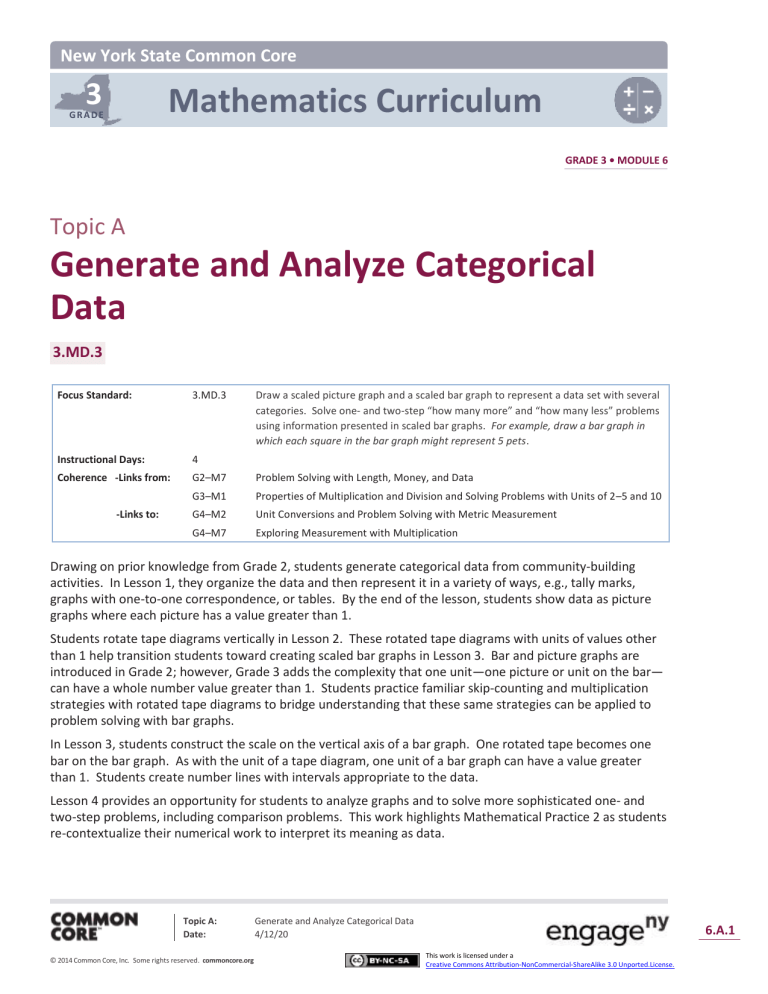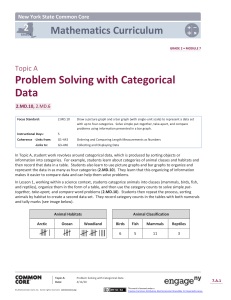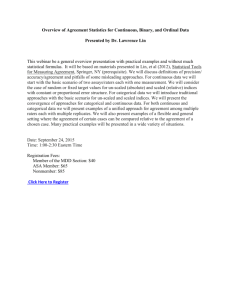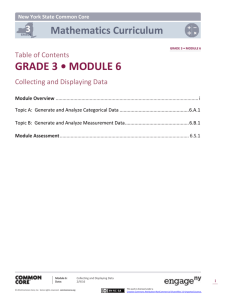Grade 3 Mathematics Module 6, Topic A, Overview

New York State Common Core
3
G R A D E
Mathematics Curriculum
GRADE 3 • MODULE 6
Topic A
Generate and Analyze Categorical
Data
3.MD.3
Focus Standard: 3.MD.3
Instructional Days: 4
Coherence -Links from: G2–M7
-Links to:
G3–M1
G4–M2
G4–M7
Draw a scaled picture graph and a scaled bar graph to represent a data set with several categories. Solve one- and two-step “how many more” and “how many less” problems using information presented in scaled bar graphs. For example, draw a bar graph in
which each square in the bar graph might represent 5 pets.
Problem Solving with Length, Money, and Data
Properties of Multiplication and Division and Solving Problems with Units of 2–5 and 10
Unit Conversions and Problem Solving with Metric Measurement
Exploring Measurement with Multiplication
Drawing on prior knowledge from Grade 2, students generate categorical data from community-building activities. In Lesson 1, they organize the data and then represent it in a variety of ways, e.g., tally marks, graphs with one-to-one correspondence, or tables. By the end of the lesson, students show data as picture graphs where each picture has a value greater than 1.
Students rotate tape diagrams vertically in Lesson 2. These rotated tape diagrams with units of values other than 1 help transition students toward creating scaled bar graphs in Lesson 3. Bar and picture graphs are introduced in Grade 2; however, Grade 3 adds the complexity that one unit — one picture or unit on the bar — can have a whole number value greater than 1. Students practice familiar skip-counting and multiplication strategies with rotated tape diagrams to bridge understanding that these same strategies can be applied to problem solving with bar graphs.
In Lesson 3, students construct the scale on the vertical axis of a bar graph. One rotated tape becomes one bar on the bar graph. As with the unit of a tape diagram, one unit of a bar graph can have a value greater than 1. Students create number lines with intervals appropriate to the data.
Lesson 4 provides an opportunity for students to analyze graphs and to solve more sophisticated one- and two-step problems, including comparison problems. This work highlights Mathematical Practice 2 as students re-contextualize their numerical work to interpret its meaning as data.
Topic A:
Date:
© 2014 Common Core, Inc. Some rights reserved. commoncore.org
Generate and Analyze Categorical Data
4/12/20
This work is licensed under a
Creative Commons Attribution-NonCommercial-ShareAlike 3.0 Unported.License.
6.A.1
NYS COMMON CORE MATHEMATICS CURRICULUM
A Teaching Sequence Toward Mastery to Generate and Analyze Categorical Data
Objective 1: Generate and organize data.
(Lesson 1)
Objective 2: Rotate tape diagrams vertically.
(Lesson 2)
Objective 3: Create scaled bar graphs.
(Lesson 3)
Objective 4: Solve one- and two-step problems involving graphs.
(Lesson 4)
Topic A
3 6
Topic A:
Date:
© 2014 Common Core, Inc. Some rights reserved. commoncore.org
Generate and Analyze Categorical Data
4/12/20
This work is licensed under a
Creative Commons Attribution-NonCommercial-ShareAlike 3.0 Unported.License.
6.A.2









